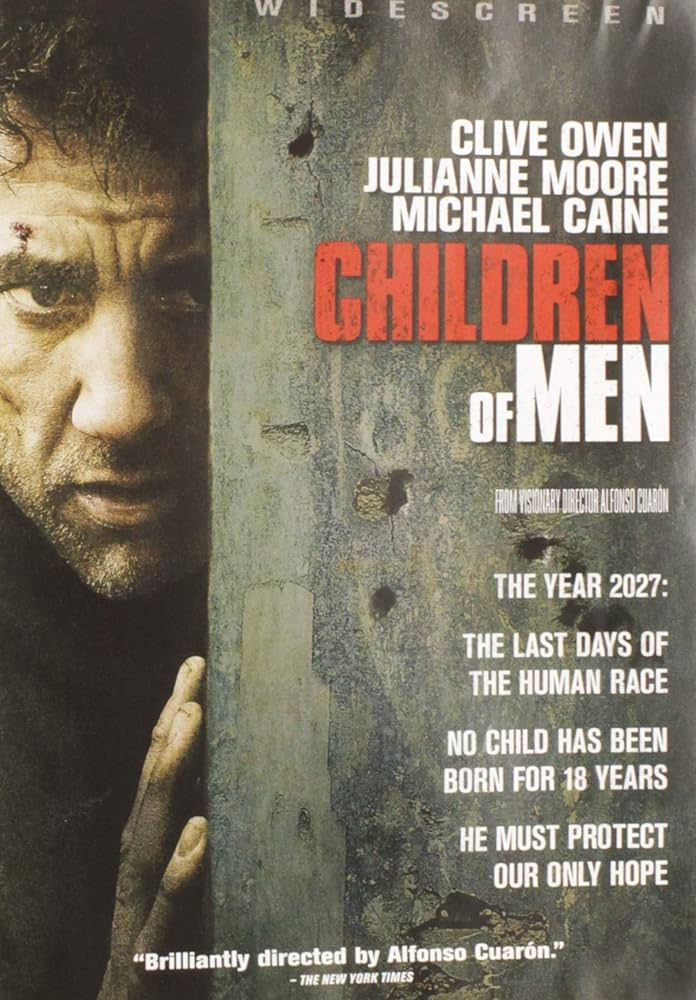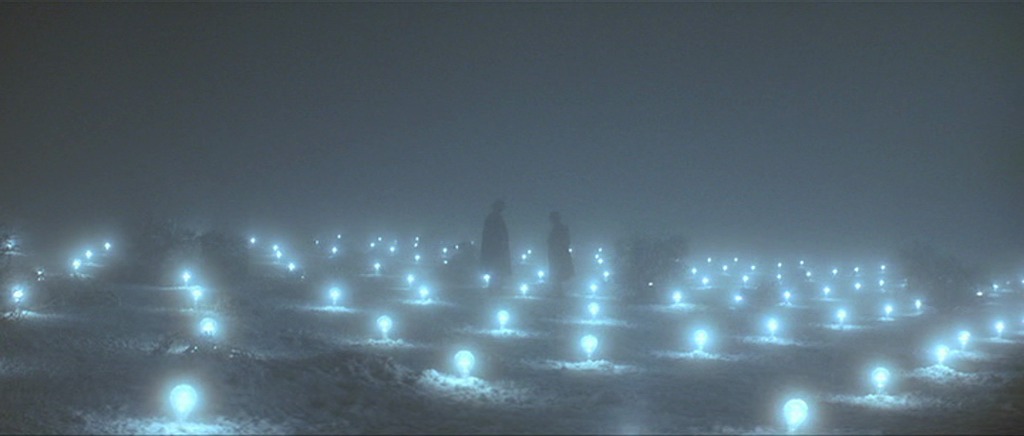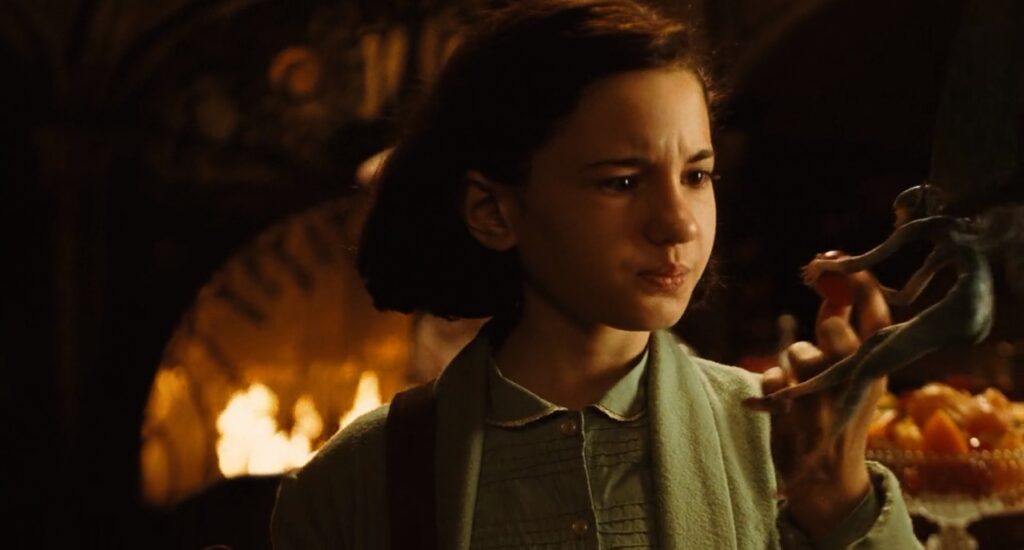“Children of Men” (2006): A Prophetic Vision of Despair and Hope Amidst Global Infertility – Film Review

Alfonso Cuarón’s “Children of Men” (2006) is a cinematic masterpiece that blends dystopian fiction with hauntingly realistic portrayals of societal collapse. Based on P.D. James’s novel, the film presents a near-future world of 2027 where humanity faces extinction due to two decades of global infertility. Its narrative and thematic depth, combined with groundbreaking filmmaking techniques, make it a compelling study of despair, hope, and the human condition.
A World Without Children: The Premise
“Children of Men” thrusts the audience into a bleak future where no children have been born for 18 years, leading to global despair and societal breakdown. The film follows Theo Faron (Clive Owen), a disillusioned bureaucrat, who becomes the unlikely protector of Kee (Clare-Hope Ashitey), the first pregnant woman in nearly two decades. Their journey is both a literal and metaphorical quest for salvation, not just for Kee and her unborn child but for a world teetering on the brink of oblivion.
Reflecting Reality: Infertility in 2024
As of 2024, the real-world issue of declining fertility rates has become a pressing concern, mirroring the dystopian premise of “Children of Men.” Factors such as environmental degradation, lifestyle changes, and economic instability contribute to this trend, making the film’s themes more relevant than ever. Cuarón’s portrayal of a world grappling with the consequences of widespread infertility resonates with contemporary anxieties, highlighting the film’s prophetic vision and its urgent call for introspection and action.
Filmmaking Mastery: Behind the Scenes
One of the most remarkable aspects of “Children of Men” is its technical execution, particularly the use of extended single-shot sequences that immerse viewers in the film’s visceral reality. Cuarón, along with cinematographer Emmanuel Lubezki, crafted scenes of extraordinary complexity and intensity, such as the ambush on the country road and the climactic battle in Bexhill refugee camp, which are presented in real-time, unbroken takes. These sequences required meticulous planning, choreography, and precision in execution, pushing the boundaries of film technology and storytelling.
The use of practical effects, natural lighting, and handheld camera work enhances the film’s gritty, documentary-like aesthetic, creating a sense of immediacy and authenticity. The production design, led by Jim Clay and Geoffrey Kirkland, meticulously crafted the decaying urban and rural landscapes, reflecting a world of neglect, despair, and resistance.
Thematic Resonance: Despair, Hope, and Human Resilience
At its core, “Children of Men” is a meditation on the resilience of the human spirit in the face of overwhelming despair. The film’s dystopian world, marked by authoritarianism, environmental collapse, and social disintegration, serves as a backdrop for exploring themes of hope, redemption, and the innate drive for survival and renewal. Theo’s transformation from a passive bystander to an active participant in Kee’s journey underscores the narrative’s belief in the potential for individual and collective salvation.
Cultural and Critical Impact
Upon its release, “Children of Men” received critical acclaim for its innovative storytelling, technical prowess, and powerful thematic exploration. Over time, its reputation has only grown, with many considering it a landmark in science fiction and dystopian cinema. The film’s ability to blend thrilling action with profound philosophical inquiry has cemented its status as a modern classic, offering a poignant reflection on the human condition and the challenges facing contemporary society.
“Children of Men” in the Pantheon of Sci-Fi Cinema
“Children of Men” stands as a testament to the power of cinema to reflect and interrogate the human experience. Its blend of gripping narrative, technical innovation, and thematic depth makes it a touchstone for understanding the anxieties and hopes of the 21st century. As the real-world parallels of infertility and societal strife become increasingly pronounced, Cuarón’s film remains a vital and prescient work, offering not just a cautionary tale but also a glimmer of hope in the enduring capacity for human empathy and resilience.
Production Innovations and Challenges
“Children of Men” is renowned for its technical achievements, particularly the long, unbroken takes that immerse the audience in the film’s tense atmosphere. These sequences were not just a stylistic choice but also a narrative tool, creating an unflinching realism that accentuates the story’s urgency and desperation. Achieving these shots required innovative techniques, including custom-built camera rigs and precise coordination among the cast and crew. The car ambush scene, for example, involved a rig that allowed 360-degree camera movement inside a compact space, capturing the actors’ performances and the surrounding chaos in one fluid motion.
Character Arcs and Performances
Clive Owen’s portrayal of Theo Faron is a cornerstone of the film, presenting a journey from apathy to action that mirrors humanity’s potential for change. Theo’s evolution is marked by loss, resilience, and ultimately, hope, a narrative arc that Owen conveys with nuanced depth. Clare-Hope Ashitey as Kee is the symbol of future possibilities, her character’s strength and vulnerability serving as a catalyst for the story’s progression. The supporting cast, including Michael Caine as the aging hippie Jasper and Julianne Moore as the activist Julian, add layers to the film’s exploration of resistance, sacrifice, and faith in the face of adversity.
Thematic Exploration: Beyond the Surface
Beyond its immediate narrative, “Children of Men” delves into deeper themes of societal decay, the erosion of civil liberties, and the environmental crises that mirror our contemporary challenges. The film’s depiction of a world ravaged by infertility, xenophobia, and authoritarian rule resonates with today’s global issues, from population declines and migration crises to the rise of nationalism and the erosion of democratic norms.
The Relevance of “Children of Men” in 2024
In the context of 2024, with increasing concerns about global infertility rates, environmental degradation, and political instability, “Children of Men” holds a prophetic significance. The film’s exploration of these themes underscores the interconnectedness of social, environmental, and political factors in shaping our collective future. Its portrayal of a world on the brink serves as a cautionary tale, urging contemporary audiences to reflect on the direction of our society and the legacy we wish to leave for future generations.
Legacy and Enduring Impact
Since its release, “Children of Men” has grown in stature, often cited for its prescient portrayal of a world in crisis and its innovative cinematic techniques. Its influence extends beyond the realm of film, inspiring discussions in literary, political, and philosophical circles about the trajectory of human civilization and the moral imperatives of our time.
In the landscape of science fiction and dystopian cinema, “Children of Men” stands out for its ability to fuse groundbreaking filmmaking with profound thematic inquiries. It challenges viewers to confront uncomfortable truths about our world while offering a sliver of hope in the enduring human capacities for compassion and resilience.
Reflections on Humanity and Hope
Ultimately, “Children of Men” is a film that transcends its dystopian trappings to offer a meditation on the human condition. It prompts us to consider what defines us in the face of oblivion and how the acts of caring, protecting, and believing in a better future are what truly sustain human society. In its blend of despair and hope, “Children of Men” offers a vision of humanity that is as challenging as it is inspiring, making it a vital work of art for our times and beyond.




